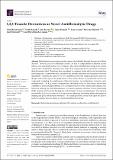1,2,3-Triazole Derivatives as Novel Antifibrinolytic Drugs
Author(s)
Bosch-Sanz, Oriol; Rabadà, Yvette; Biarnés, Xevi; Pedreño, Javier; Caveda, Luis; Balcells, Mercedes; Martorell, Jordi; Sánchez-García, David; ... Show more Show less
Downloadijms-23-14942.pdf (4.503Mb)
Publisher with Creative Commons License
Publisher with Creative Commons License
Creative Commons Attribution
Terms of use
Metadata
Show full item recordAbstract
Fibrinolysis is a natural process that ensures blood fluidity through the removal of fibrin deposits. However, excessive fibrinolytic activity can lead to complications in different circumstances, such as general surgery or severe trauma. The current antifibrinolytic drugs in the market, aminocaproic acid (EACA) and tranexamic acid (TXA), require high doses repetitively to maintain their therapeutic effect. These high doses are related to a number of side effects such as headaches, nasal symptoms, or gastrointestinal discomfort and severely limit their use in patients with renal impairment. Therefore, the discovery of novel antifibrinolytics with a higher specificity and lower dosage could vastly improve the applicability of these drugs. Herein, we synthesized a total of ten compounds consisting of a combination of three key moieties: an oxadiazolone, a triazole, and a terminal amine. The IC<sub>50</sub> of each compound was calculated in our clot lysis assays, and the best candidate (<b>1</b>) provided approximately a 2.5-fold improvement over the current gold standard, TXA. Molecular docking and molecular dynamics were used to perform a structure–activity relationship (SAR) analysis with the lysine binding site in the Kringle 1 domain of plasminogen. This analysis revealed that 1,2,3-triazole was crucial for the activity, enhancing the binding affinity through pi–pi stacking and polar interactions with Tyr72. The results presented in this work open the door to further investigate this new family as potential antifibrinolytic drugs.
Date issued
2022-11-29Department
Massachusetts Institute of Technology. Institute for Medical Engineering & SciencePublisher
Multidisciplinary Digital Publishing Institute
Citation
International Journal of Molecular Sciences 23 (23): 14942 (2022)
Version: Final published version